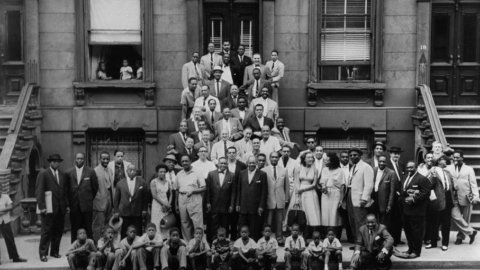A part of the exhibition will be dedicated to the portraits and famous photos of the major icons of music of the XNUMXs, a section no less consistent with civil commitment (above all the struggle for the civil rights of African-Americans and Indians, religious fundamentalism, Vietnam, the nuclear nightmare of Hiroshima, consumerism, the growing degradation of the environment), to visionary existential reflections obtained from the "sandwich" of several slides (a pioneering technique in an age without Photoshop), to photographic illustrations of the texts of Dylan and the Beatles and fashion, without forgetting the evolution of American society, all fixed with such an original and visionary gaze as to win honors, awards and the covers of the most prestigious international magazines.
“I want to communicate the invisible elements in a personality”, said Art Kane, enclosing all his poetics in a few words.
“I think of Art Kane as a bright color, shall we say, like a pumpkin sun in the middle of a blue sky. Like the sun, Art fixes his gaze on his subject, and what he sees, he photographs, and usually it's a dramatic interpretation of his personality”. So Andy Warhol said about him.
“Art Kane was my idol – recalls Franco Fontana – almost a mirage for me who admired him from afar. Then I met him in '77 in Arles and we became 'colored' brothers linked by an unforgettable relationship of friendship and intimacy. He was a brilliant man, of great intelligence and creativity. Animated by the impossible myth of eternal youth and continuous rebirth, he bit into life to the core: he even wanted to make a musical out of it. He rode around New York in Velosolex and one evening he took me to the legendary Studio 54, arriving fully dressed as a cowboy. He adored women and photographed them with a sensitivity and eroticism in which I fully found myself. He loved Italy where he had come several times, even for the workshops organized by me. Hypercritical of the students, he scolded them mercilessly, provoking and encouraging them to always dig deep into their subconscious ”.
Art Kane is the legendary photographer who at 10 on an August morning in 1958 immortalized as many as 57 jazz legends for the magazine "Esquire" on a sidewalk of 126th street, in Harlem, unaware of having created the most significant image in the history of jazz, universally known as "Harlem 1958". A photograph that earned him a Gold Medal from the Art Directors Club of New York and powerful enough to inspire a book, an Oscar-nominated 1994 documentary (“A Great Day in Harlem”), and more recently a Spielberg film, “The Terminal” (2004), with Tom Hanks.
Kane's lens then rested on other times on the greats of music, of every music, from the Rolling Stones to Bob Dylan, to the Doors, to Janis Joplin, to Jefferson Airplane, and again Frank Zappa, Cream, Sonny & Cher, Aretha Franklin, Louis Armstrong, Lester Young, creating an endless series of icons, such as, above all, the memorable one of the Who wrapped in the British flag. But Kane was much more: one of the true masters of XNUMXth century photography, whose visionary images influenced the social consciousness of more than a generation and left their mark on world culture.
Images that are now in the permanent collections of the Museum of Modern Art and the Metropolitan Museum of Art.
Art kane (1925-1995) worked in fashion, publishing, shot celebrity portraits, travel reports, and treated the nude with a relentless and innovative eye. As with his contemporaries, Guy Bourdin (1928-1991) and Helmut Newton (1924-2004), Kane's work gravitates around three main elements: bold colours, eroticism and surreal humour. Standard bearer of that wild esprit which, above all thanks to him, established itself after the Second World War: inflexible, uncompromising and sentimental.
Born in the Bronx, New York, in 1925 (the Kanofsky family - this is his real surname - had moved there in the early 900s, between 1900 and 1910, from Ukraine) Kane fought in the Second World War in France in a picturesque contingent assigned to inflatable tanks that were supposed to mislead the Germans.
After graduating with honors from Cooper Union in 1950, and after studying with Alexey Brodovitch at the New School, along with Richard Avedon, Irving Penn and Diane Arbus, at the age of 27 he became the youngest art director in history entering the magazine “Seventeen”. In 1958 the consecration with the portrait of jazz legends on a Harlem sidewalk.
With his work, while the battle for civil rights and the war in Vietnam raged, Kane then gave a conscientious response to the period he was living, expressing himself in a popular way, showing a great ability to communicate with a large audience.
In years in which still analog camera technology progressed at a paroxysmal speed, the 35mm format was liberating for Kane: "I love the ritualistic aspect of the medium, the embryonic sense of getting lost in the magic window of the viewfinder, the incredible gratification of being in the temple I created myself. I looked ridiculous with my jacket over my head because nobody used to cover it when shooting with a 35mm, but I loved that alienation, being totally removed from the outside world, as if I had my own little theater at my disposal”.
Thirty years before Photoshop, armed only with a light table and a magnifying glass, Kane invented the "sandwich" image by mounting two register slides in the same frame. By developing this technique beyond all limits, Kane has become a true pioneer of photographic storytelling, which he conducted also using metaphor and poetry, effectively transforming photography into illustration.
He then went through the sixties, seventies and eighties like a fury, revolutionizing commercial photography, fashion images, celebrity portraits and the nude, thanks to a reckless use of the wide angle, of films with hypersaturated colors and a surreal with a high erotic rate.
Kane was also a key contributor to the leading fashion magazines of his era, and penned astonishing advertising campaigns for both the fashion and beauty industries.
Very close to Italy, he came to our country on several occasions to photograph and to give life to workshops.
Throughout his career Kane has been honored by nearly every photo-design organization in the United States including: American Society of Magazine Photographers, Photographer of the Year, Newspaper Guild of America, Page One Award, Augustus Saint-Gaudens Medal for Distinguished Achievement, Cooper-Union, New York Art Directors Club. In 1984 Kane received the American Society of Magazine Photographers Lifetime Achievement Award and has received major accolades from numerous American corporations and corporations.
“Art Kane was an illusionist – writes Guido Harari -, the master of a photographic impressionism that still today stirs up emotions and distills ideas. Venice is always in danger, rock musicians always announce the advent of some New World, loneliness in the age of the Internet is even more cosmic, civil rights must be renegotiated every single day, environmental degradation pushes us ever more rapidly towards extinction, and Kane, with an astonishing actuality, was already projecting all this into a world of fantasy that seems to amplify today's reality. In a few years he revolutionized photography, discovering new techniques and personalizing others to free it from its presumed "realism". Kane's photography is pure energy, true imagination in power: "Reality for me never lives up to the visual expectations it generates," he said. “More than recording it with my photos, I want to share the way I feel things”.
All Kane's photographs are pervaded by his irrepressible passion for life, for man and for a popular culture to be interpreted through symbols. His are thinking images, visions that always communicate a very personal point of view, on racism and war, mysticism or sex, fashion or music. No worries about "style": his photographic technique was intuitive and disarming in its simplicity, animated by an impressive variety of ideas, improbable camera angles, singular settings and saturated colors. Nothing appears as we would expect: the images suggest, provoke, displace, but it's up to the viewer to complete the picture.
The Fifties also anticipated the color revolution that Kane seized on the fly, knowing well, thanks to his award-winning experience as an art director, how to lay out his visions and above all how to select them. His ferociously surgical editing left extremely rare alternative shots in his vast archive: "I immediately understood that photography can also be an act of refusal, which lets you choose what to leave out of the image".
Kane honed his talent on legendary magazines such as "Look", "Life", "Esquire" and "McCall's", now defunct (except for "Esquire") but at the time generous with fabulous fees just to obtain images that "eliminate the small and the ugly to emphasize the great and the heroic”, pushing on the path of visionary even when fashion knocked on his door in the person of Diana Vreeland, the powerful madame of “Vogue”. From the depth of field and marked distortion of the 21mm wide angle (invented in those years) to the "selective focus" obtained with telephoto lenses such as the 180mm and 500mm, his visual vocabulary was also enriched with images conceived to be viewed upside down down and ingenious montages of two slides his so-called 'sandwichs', of which this exhibition presents numerous examples. “I use the sandwich as a poetic tool to escape from photorealism – said Kane -. It's like life: things happen, but they aren't necessarily dramatic, until you step back and capture their essence based on your memory. Memory is extraordinary. When you have the audacity to extract an image from the living, one-dimensional world, you have eliminated smells, touch, sound, and put a frame around it eliminating peripheral vision. In this sense no photo is the truth, no matter how realistic the image, or how normal the lens. They all lie, because we always mount. In normal vision, we pick one thing at a time, but we're always moving our eyes, combining everything continuously."
The exhibition is organized and produced by the Civic Gallery of Modena and the Cassa di Risparmio di Modena Foundation in collaboration with the Solares Foundation of the Arts of Parma and the Wall of Sound Gallery of Alba, this major retrospective dedicated to Art Kane twenty years after his death and on the ninetieth anniversary of his birth, presents for the first time in Italy a hundred classic and unpublished photographs that have contributed to shaping the visual imagination of the second half of the twentieth century.
Photo: “A great day in Harlem” by A. Kane, 1958 (source: wikipedia.org)





